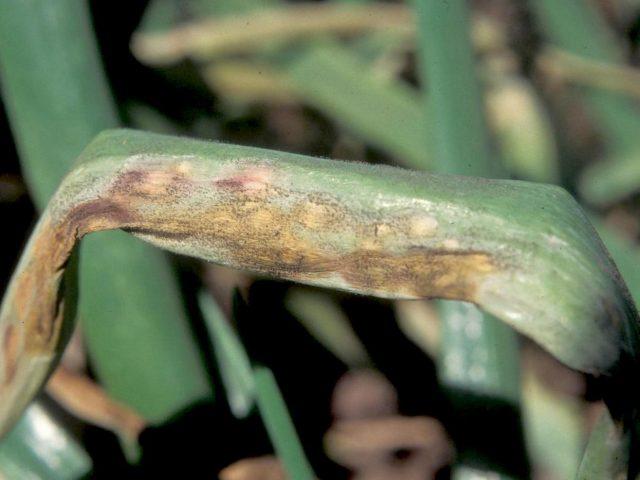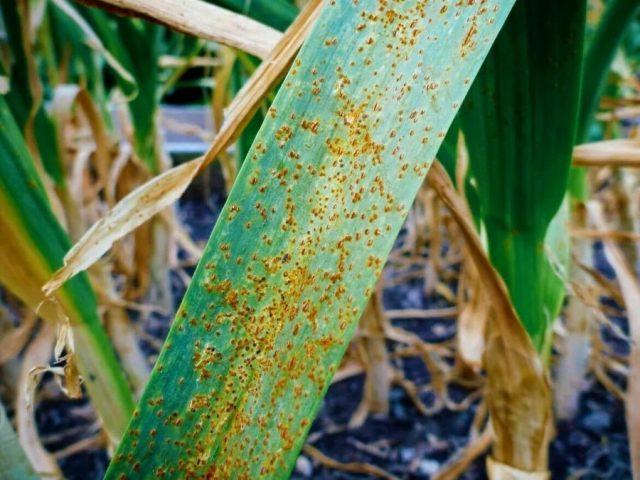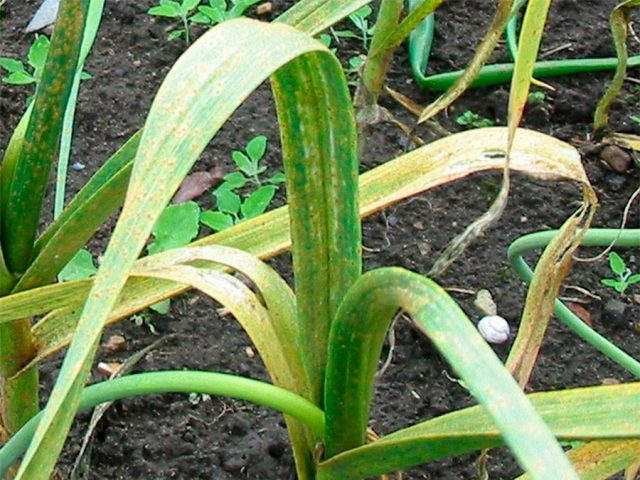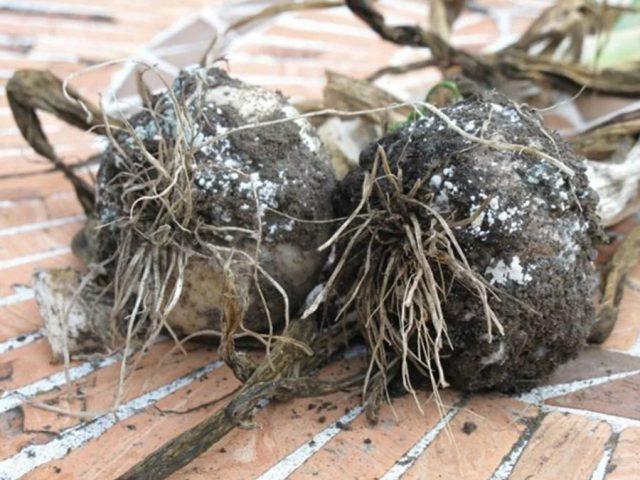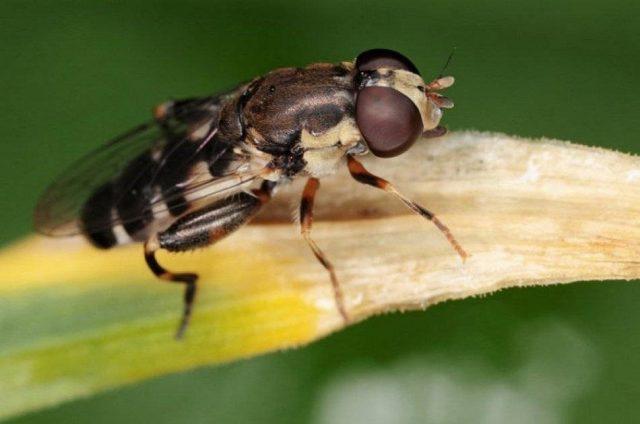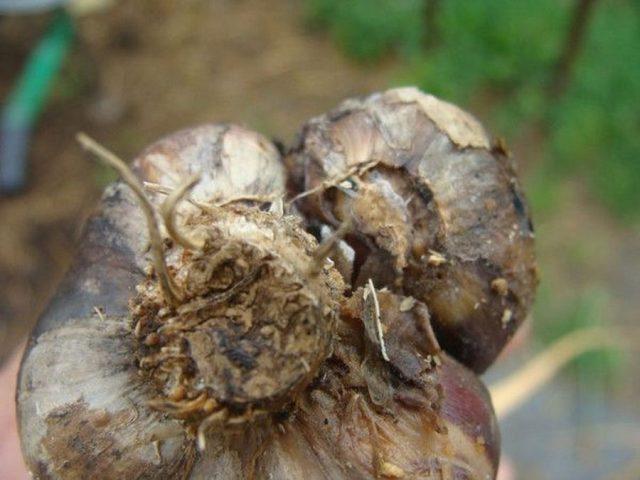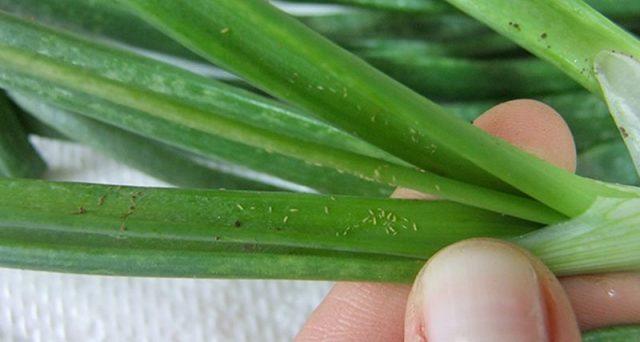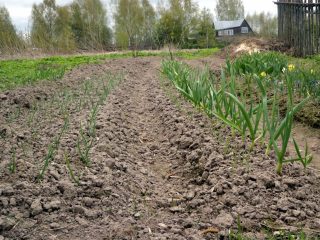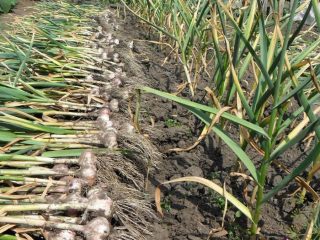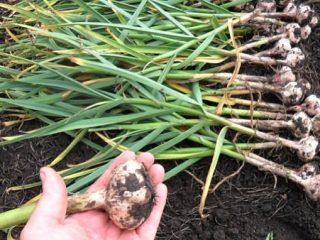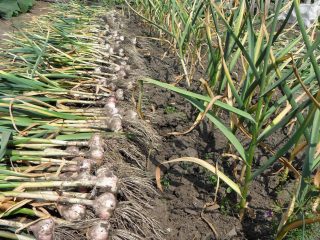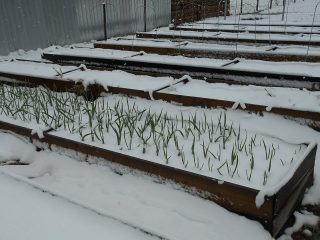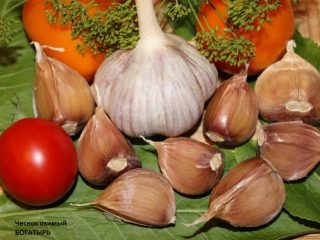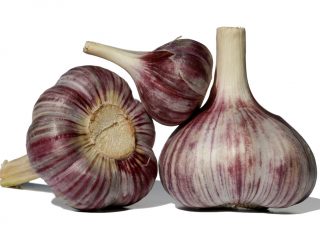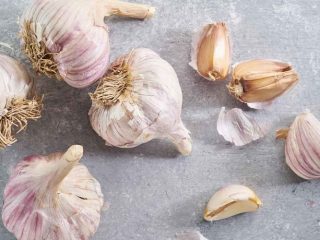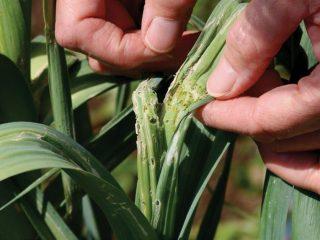Content
Garlic turns yellow in the spring for many reasons. To deal with the problem, you need to evaluate the conditions on the site and the quality of crop care.
Why do garlic leaves turn yellow in spring?
The tips of garlic leaves turn yellow in the spring due to unfavorable weather conditions, against the background of violations of agricultural practices, or due to the influence of fungi. There are several main reasons for the problem.
Low temperature
If garlic turns yellow in the spring, the reason may be the negative impact of temperature changes. Young seedlings do not tolerate cold weather well; night frosts damage the leaves.
The plates turn yellow especially often when growing crops in open ground in the middle zone and the Urals. To protect the garlic, it is recommended to keep the seedlings under film at first.Slightly damaged plants can be treated with Zircon and Epin - they will help restore the crop.
Excess or lack of moisture
If garlic leaves turn yellow in the spring in a greenhouse or in the ground, this may be caused by a violation of the watering regime. The culture loves moderate moisture; when growing, it is necessary to equally avoid waterlogging and drying out of the soil.
As a rule, in April and May, garlic beds are watered at least 2-3 times a month. The intensity of humidification can be reduced in rainy and cool weather. During drought, watering is carried out more often, up to twice a week.
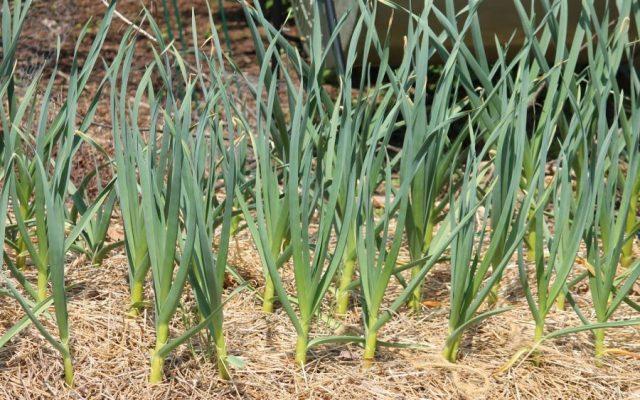
It is necessary to stop watering garlic a month before harvesting.
Unsuitable soil
The health of a crop largely depends on the quality of the soil. Garlic turns yellow in April in acidic soil with a high nitrogen content. Areas with sandy or loamy soil with good fertility indicators are best suited for growing the crop. The place should be well-lit, level, located on a slight hill. Garlic should not be planted in the shade or lowlands.
If the soil in the area with the crop is too acidic and the leaves turn yellow, liming is necessary. It is allowed to add chalk, dolomite flour and similar products to the soil.
Nutrient deficiencies
The leaves of winter garlic turn yellow in the spring due to a deficiency of useful elements in the soil. Problems especially often arise against the background of a lack of nitrogen. The leaves first turn pale to light green and then turn yellow. Shoots develop worse, grow slowly, and often wither.
Potassium deficiency also has a negative effect on the condition of the plates.If garlic lacks an element, metabolic processes are disrupted and the plant becomes more vulnerable to viruses and fungi. Potassium deficiency can be determined not only by yellowing of the leaves, but also by the appearance of a bluish tint and a brownish edge on the plates.
Poor quality planting material
If the lower leaves of garlic turn yellow in the spring, this may indicate initially low-quality plant material. To plant the crop, you must use only strong, juicy, dry cloves. They should not have black spots or rotten areas. You should not use seedlings if they give off an unpleasant musty odor.
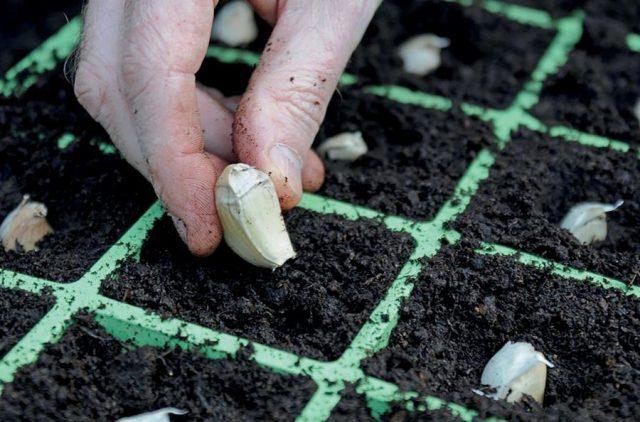
When planting low-quality cloves, the yield and taste properties of garlic will be low
Before planting garlic cloves in the spring, they need special treatment. Typically, the preparation of seedlings is carried out as follows:
- Stir 1 g of potassium permanganate in 200 ml of water.
- Dip the cloves into the resulting light pink solution.
- Leave the material in the liquid for ten hours.
After pickling, the cloves need to be washed and dried thoroughly. After this, planting is carried out in open ground or seedlings.
Errors during landing
Garlic feathers turn yellow in the spring due to non-compliance with agricultural practices. When growing crops, it is necessary to avoid basic blunders. In particular, it is recommended:
- plant the cloves to a depth of 5-7 cm, without recessing them too much and not placing them close to the surface;
- avoid sowing crops in cold weather with a high probability of return frosts;
- plant spring garlic in the spring, and winter garlic before the onset of winter;
- do not place the culture in one place for several years in a row.
When planting before winter, the procedure is carried out approximately three weeks before the cold weather. If you sow cloves too late, they may suffer from frost and produce poor-quality seedlings in the spring.
Garlic diseases
If winter garlic turns yellow in May, the problem may be caused by numerous diseases. Crops in greenhouses and garden beds are affected by several fungal diseases:
- Downy mildew. The disease leaves light, blurry spots on the leaves, then a gray coating forms on the plates. Garlic gradually turns yellow and fades.
Downy mildew most often spreads to garlic from contaminated soil in the spring.
- Rust. Rusty growth spots appear on the leaves of the crop. If left untreated, the fungus quickly causes the plant to wilt.
Rust develops in waterlogged, acidic soil.
- Mosaic. With a viral disease, the leaves turn yellow and a peculiar pattern appears on them. In addition, the feathers become thinner and deformed.
The mosaic is transferred to the garlic from a dirty garden tool or is blown away by the wind
- White rot. Garlic bulbs in the soil become moldy and become covered with a soft, light coating. The plant begins to rot, its leaves turn yellow and die.
White rot of garlic develops with a lack of nitrogen in the soil and against the background of drought.
At the first symptoms of fungal diseases, garlic plantings should be sprayed with fungicides - Bordeaux mixture, Fitosporin or Maxim. It is better to immediately remove severely damaged plants from the garden bed so that they do not infect neighboring plants.
Pests
Garlic in the garden turns yellow in the spring not only due to pests, but also due to the activity of parasitic insects. Most often the culture is affected by:
- onion fly - the pest lays eggs in underground fruits, the larvae suck out the juice of the scales and lead to the death of garlic;
Garlic feathers turn yellow due to the presence of onion flies, as the nutritional processes of the crop are disrupted
- nematode - the insect attacks the roots of the plant, the feathers stop receiving nutrients, turn yellow and dry out;
It is impossible to cure garlic nematode; affected plants must be eliminated
- tobacco thrips - a small brown midge feeds on the juice of garlic leaves, because of this the plates become covered with light marks, turn yellow and wither.
In warm weather, thrips appear in spring beds at the end of May
You can get rid of pests by spraying with insecticides Aktara, Iskra or Fitoverm. Treatments are usually carried out three times from spring to autumn at intervals of at least two weeks.
What to do if the garlic turns yellow in the spring in the garden
If garlic leaves turn yellow in May, you must first of all carefully examine the affected plant and determine what caused the problem. The following measures are usually taken:
- remove severely yellowed garlic from the greenhouse or site, which in any case cannot be returned to its normal state;
- if necessary, thin out the beds with crops to improve air circulation and provide the plants with sufficient light;
- spill the soil with a solution of Epin or Zircon, and also spray the plantings - growth stimulants will strengthen the endurance of garlic and contribute to its recovery.
To understand whether the yellowing of leaves in spring is caused by a violation of agricultural practices or diseases, it is necessary to dig up one of the affected plants and inspect the underground part. If the garlic has been damaged by a fungus, the bulb will be rotten or wrinkled and dry.
If there are symptoms of disease, the bed with the plant is spilled with a solution of Fitosporin or a similar fungicidal agent. It is also recommended to powder the soil with wood ash - it will improve the composition of the soil and prevent the re-development of the disease.
How to feed garlic to prevent yellowing in May
Yellowing of garlic leaves in May is not always associated with diseases. Changes in feather color in spring often occur on poor soil; the plant simply does not have enough nutrients. In this case, the crop needs to be fed with mineral elements.
Fertilizing garlic with urea
Nitrogen is primarily responsible for the active development of green mass. Leaves often turn yellow if there is not enough of this substance in the soil. To correct the situation, you can add urea to the soil. The procedure is carried out as follows:
- The row spacing in the bed is loosened and shallow grooves are made in the center.
- Urea granules are poured into the grooves - 15-20 g per 1 m2.
- The fertilizer is covered with soil and the beds are moistened abundantly.
After applying urea and watering, it is recommended to mulch the soil on the site. In this case, it will remain moist longer, and the nitrogenous fertilizer will be able to properly dissolve in the soil.
Fertilizing with ammonia
If there is a mild lack of nitrogen, ammonia can be used to feed garlic in the spring. The diagram looks like this:
- About 15 ml of the drug is diluted in a bucket of water.
- Mix thoroughly until completely homogeneous.
- Water the beds in dry, sunny weather.
Before applying the ammonia solution, it is important to routinely moisten the soil. Otherwise, even a drug with a low concentration can leave burns on the roots.
Fertilizing garlic with potassium
Garlic turns yellow in the summer from potassium deficiency, especially if the soil on the site is very poor and fertilizing is carried out rarely. You can fertilize the crop in the following way:
- About 5 g of potassium sulfate is stirred in 1 liter of warm water.
- Bring the solution until smooth so that there is no sediment at the bottom.
- Spray with a spray bottle.
Treatment in spring should be done in the morning or evening. The solution can also be used for irrigation; in this case, you need to stir 20 g of the drug in a bucket of water.
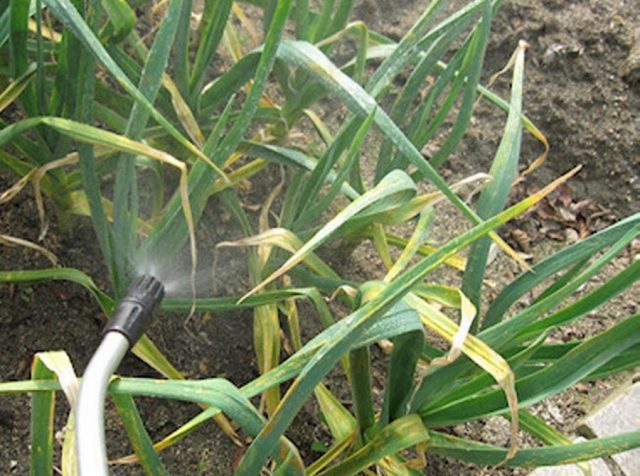
Spraying garlic with potassium and other nutrient solutions is carried out only in calm weather.
Prevention measures
Treating garlic to prevent yellowing of leaves in the spring usually gives good results. But it is advisable in principle to prevent the problem from developing. When growing crops, you must follow certain rules of prevention:
- choose the hardiest varieties with good immunity to diseases for planting on poor soil;
- treat the cloves with fungicides or potassium permanganate before sowing in the ground;
- plant garlic in the same place for no more than two years in a row;
- Before sowing the crop, dig up the soil deeply and add compost or organic fertilizers containing phosphorus and potassium;
- try to plant in a timely manner - after the onset of final warmth in the spring or before the end of October in the fall;
- when growing crops, control the amount of watering and regularly loosen the soil;
- With the onset of autumn, remove all plant debris from the beds and dig up the soil properly.
It is recommended to use only strong, healthy cloves without damage for planting in spring. Low-quality material will not produce good shoots in any case. To prevent diseases, it is necessary to plant garlic away from onions. The best places for the culture are places where cabbage, zucchini or pumpkin previously grew.
When growing garlic in acidic soil, it is recommended to add dolomite flour to the soil from time to time. It will help bring the pH closer to neutral and also prevent nematode infection of the crop.
Conclusion
Garlic turns yellow in the spring due to non-compliance with care rules, bad weather and poor soil. In most cases, the problem can be eliminated by fertilizing or using treatment for diseases and pests.
